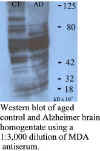Malondialdehyde (MDA) is a natural product formed in all
mammalian cells either as a product of lipid peroxidation, or as a
by-product of prostaglandin and thromboxane biosynthesis.
Although MDA can be broken down by aldehyde dehydrogenases, its
production is accelerated by oxidative stress and when its concentrations
reach critical levels, it may escape this detoxification process.
It is highly reactive and known to bind covalently with primary
amino groups of proteins, phospholipids, or DNA, but has no known
physiological function. This
covalence modification of cellular molecules may cause structural
modifications, which results in dysfunction or inactivation. MDA is toxic
and has been implicated in aging, mutagenesis, carcinogenesis, radiation
damage and a number of other pathological processes.
MDA is known to increase in tissue and plasma samples with
age . It is known to bind to
low density lipoprotein resulting in the recognition of the MDA-modified
LDL by scavenger receptors on macrophages.
It has also been shown to be present in renal glomerular lesions in
diabetics, implicating oxidative stress as being involved in the
pathogenesis of diabetic nephopathy.
MDA has been shown to be increased in the brains of aged
individuals and further increased in Alzheimer brains.
. It is known to bind to
low density lipoprotein resulting in the recognition of the MDA-modified
LDL by scavenger receptors on macrophages.
It has also been shown to be present in renal glomerular lesions in
diabetics, implicating oxidative stress as being involved in the
pathogenesis of diabetic nephopathy.
MDA has been shown to be increased in the brains of aged
individuals and further increased in Alzheimer brains.
A goat antiserum to MDA is currently available. This
antiserum has been shown to be immunoreactive with MDA-modified bovine
serum albumin (BSA) by ELISA. Western blot analysis show sthe antibody is capable
of detecting HNE-modied proteins. This antibody should be a valuable tool for scientists
working to understand the role of MDA in the pathogenesis of various
diseases.
(BSA) by ELISA. Western blot analysis show sthe antibody is capable
of detecting HNE-modied proteins. This antibody should be a valuable tool for scientists
working to understand the role of MDA in the pathogenesis of various
diseases.
MDA-modified
BSA (Cat no. HMP039H) which can be used as a positive control or to
neutralize immunoreactivity is also available.
Manufacturing
Reference:
Lung, C.C, et al.
J. Immunol. Meth. 128: 127-132, 1990.